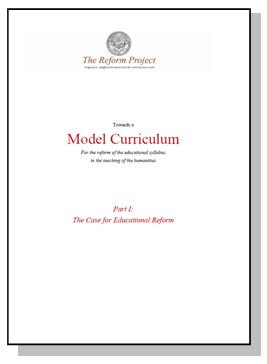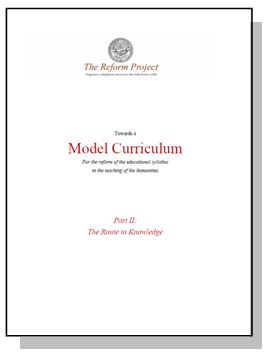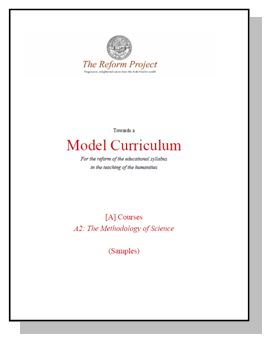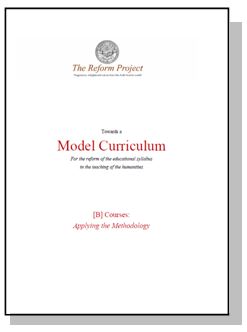Format and Structure
THE MODEL CURRICULUM PROGRAMME is designed to be distributed over a period consistent with a tertiary course of three years. That is as far down to detail as the programme will go since the aim is to provide, as far as possible, a viable ‘off the shelf’ educational syllabus that is adaptable, without great effort, to local particularities. For the ultimate purpose of the online programme is to provide detailed pointers to what a rationalising, progressive syllabus should contain, and thus constitute a flexible starting point for educational departments across the Arab Middle East to construct their national programmes.
The Model Curriculum focuses on those elements – the humanities – that have been the most resistant to change and updating, and which have been the most subject to ideologisation or the domination of the conservative-minded or change-resistant classes. Given this ideologisation, and the strength of the Islamist influence that has brought Arab education to its present state, any reconfiguration of the educational curriculum has to be constructed so as to effect the required changes incrementally. Accordingly, care has been taken to construct the modules to follow one upon the other, each module preparing the student for the module which follows.
The ordering of the Model Curriculum thus follows a sequential order that first establishes the premises of modern knowledge acquisition, applies this contemporary methodology to the historical record of the Muslim world, widens thereby the parameters of Islamic cultural authenticity, and expands the educational spectrum to include cultural training from sources outside of the Islamic heritage. In so doing it broadens the spectrum of cultural productivity and explores the implications of this enhanced spectrum for the progressive development of individual freedom, positive law, religious pluralism, cultural vibrancy and forward progression in the constituent states of the region.
The scope of the Courses and Modules in the programme in the humanities may usefully be categorised under the following broad rubrics:
- Preliminaries – The route to knowledge
- The purpose of the Model Curriculum
- Dismantling the quarantines
- The promotion of comparative cultural study
- The rise and nature of knowledge
- The historical route to knowledge
- The historical development of the scientific method
- The methodology of contemporary science
- Applying the methodology
- Modern historical methodology
- Applying the methodology to the environment of Islam’s emergence
- The scripture in history
- Revisiting the legal heritage
- The historical development of Islamic law
- The legal methodology
- The contemporary legal arena and the challenge of revitalisation of legal thought
- Revitalising Islamic thought and culture
- The revitalising of Islamic philosophical thought
- Rethinking the status and purpose of the scriptural texts.
- The revitalisation of scriptural hermeneutics
- Dismantling the doctrinal, cultural and intellectual quarantines
- The promotion of comparative faith studies
- The promotion of comparative culture studies
- The rehabilitation of the arts and the promotion of creativity
- Globalism and the future of the Muslim world
- Faith and power and the reality of Islamic governance in history
- The intellectual and Islamic doctrinal grounding of secularism and pluralism
- The construction and promotion of civil society
The Model Curriculum’s diagnosis of the educational crisis, the case for educational reform, the ordering of its syllabuses and their format and structure are illustrated in the documents featured below. Please select the image to read and download the document.
Model Curriculum – Part I – The Case for Educational Reform
According to the results of surveys analyzing the education systems in the Arab world, the most important challenge facing the educational system is its low value and deterioration. These negative developments are evidenced by the limited levels of its performance in scientific and technological research, but the lack of quality is a source of concern, especially with regard to the humanities. There are educational failures in the ethical, political, intellectual and cultural dimensions, and therefore the main requirement to remedy these failures is a radical reassessment of the basic intellectual, cultural and ideological structures of the Islamic heritage. In this context, it is important to develop the ability to present the Arab-Islamic cultural heritage in a modern, objective and impartial light, and to make this “new authenticity” something that Arab Muslim youth can appreciate with the standard of realism, and consider it at the same time a justified source of pride. In sum, what is needed is a new type of curriculum that replaces delusional remedies for delusional discontent and includes a programme that prepares the student to participate in modernity with vigor and self-confidence.
Model Curriculum – Part II – The Route to Knowledge
The intellectual, philosophical and analytical mode of thinking is a mentality not fully indigenised to Arab students, who have been schooled by indoctrination and rote learning. Progressive Muslim educationalists have highlighted the need to deconstruct and re-build the entire edifice of Arab-Islamic thought, so thatthe fundamental building-blocks of modern values such as secularism, religious freedom, human rights and the fraud-free democratic process have a chance of taking root. The Model Curriculum syllabus inculcates a new conception of the Islamic heritage, along with the value of a comparative cultures approach to education, to illustrate commonalities or problems faced in the challenges that the route to knowledge has historically posed to culture and to faith, and the solutions proposed. The key is a deeper understanding of the processes of knowledge acquisition historically, and a harmonised relationship between Islam and science that will allow contemporary epistemology to be indigenised. It will thus prepare a generation of students capable of distinguishing religious truths inherent in religious faith from scientific truths focusing on the realities of the physical world. By so doing the student will see the irrelevance of ‘red lines’ and falsely erected arenas of ‘conflict’.
Model Curriculum – [A] Courses – The Rise and Nature of Knowledge
The [A] Courses focus on the historical trajectory of the rise to knowledge, and illustrate the accumulated contribution of the ancient world, the Muslim world and the early modern period to the development of the scientific method. The aim is to inculcate an understanding of the nature of knowledge as an attitude and an approach, rather than a finite body of wisdom to be revealed to the labours of the worthy or the pious. It trains the student to nuance his decisions according to the methodology of evidence-gathering, evaluation and testing, and establishes the propriety of doubt and productive criticism as affirming, rather than enfeebling, the scientific endeavour. This preliminary groundwork is essential in order to put the students in a receptive mindset, one that does not adopt a confrontational attitude of defending an imagined attack upon Islam, or one that might lead them to consider that they are about to be ‘westernised’ in some way. Accordingly, the Model Curriculum makes the solid case for the cultural neutralism of modern methodologies of accumulating and evaluating knowledge.
The following two samples illustrate the structure and style of these [A] courses:
Model Curriculum-[A1] Course (SAMPLE) – The Historical Rise of the Scientific Method
Module A.1.1 – Antiquity – early methodology and the emergence of natural science
This module establishes the fundamental building blocks of the early scientific method. By examining its multi-cultural origins and the signal role played by Greek philosophical and scientific speculation, it demonstrates how the scientific vision, founded upon a material conception of reality, is not a cultural peculiarity of the contemporary West that may be taken or left aside at will, but something that is deeply rooted in mankind’s story, and in the long record of his speculation as to the nature of things. It is a joint enterprise of humanity on the route to knowledge.
Module A1.2 – The late antiquity transition
The period of ‘Late Antiquity’ illustrates the core features of what came to dominate the philosophical and theological world view of the Middle Ages in Europe and the Muslim world, and witnessed the transition from a largely material explanation of phenomena to one that included a stronger focus on theological explanations that will be more familiar to the Muslim student.
Model Curriculum-[A2] Course (SAMPLE) – The Methodology of Science
Modules in this Course promote the development of a scientific attitude, including the importance of doubt, questioning and self-examination as part of the process. They examine basic principles of the methodology and how to amass evidence, construct a hypothesis and interpret data honestly according to a sound sequence of investigation that remains responsive to the evidence. They illustrate an important feature of the scientific process, that is, that despite the lack of ‘certainty’ that the scientific method yields, its methodology does not lack authority; it is simply that the user has to be contented with the provisional nature of that authority. The modern scientist, contrary to expectations, is essentially humble, due to the constant scrutiny of his peers and the requirement to continuously review his hypothesis in the face of new evidence that might expand, or contract, its validity. The [A2] Course introduces to the student a new dimension to the understanding of what constitutes an authentic and authoritative route to knowledge.
Model Curriculum-[B] Courses – Applying the Methodology
The modules in the [B] Courses illustrate the techniques of modern historical methodology, and their application to the environment of Islam’s emergence. The importance of this syllabus is that the Muslim Middle East is ill-served by current textbooks that have absorbed uncritically an unscientific, ‘sacralised’ narrative of the past, with too much reliance upon the didactic purpose of the mediaeval Muslim historians. Historical works have not regularly included other criteria in other research disciplines such as literary criticism, sociology, geology, topography, linguistics, palaeography and archaeology, numismatics, comparative literature and historiography. This omission is due to a misplaced fear of damage to what is improperly conceived as the delicate fabric of faith. Yet these modern historiographic methods are adding penetrative depth to studies in the field, and are elucidating much that has been left unexplained about this momentous period for world history. The study of the Qur’ān as a historical document using modern approaches to historical analysis is of particular value in undoing the damage from the doctrine of the Qur’ān lying ‘outside of history’ and its stagnating effect on ethical development and the prospects of professing a progressive Islam in the contemporary world. Contemporary scholars employ modern historiographic methods to illustrate the essentially ‘dialogic’ approach of the Qur’ān to its environment, and make the case for continuing this dialogue, for prising open the ‘official closed corpus’ of scripture and for licensing change on much broader and more radical levels. Thus obscurities are clarified, speculations corrected and entire new vistas opened to the historical, cultural and spiritual pedigree of Islam, and to the contribution it has made, and makes, to the world.
Model Curriculum-[C] Courses – Revisiting the Legal Heritage
Islamic law has becoming the defining feature of identity in the contemporary period. Yet aside from false characterisations of the law held by Muslims and non-Muslims alike, the potential and relevance of Sharīʻa – a religiously-defined law in a progressively pluralising world environment – remains a lively debate. While conditions in which jurisprudents of the classical tradition functioned no longer apply, the response from some quarters to the incapacity in the form of auto-scholarship has failed to embrace the complexities of the modern state and has compromised the exercise of justice. While traditional-minded scholars have been resistant to change the classical model of Sharīʻa through fear of contamination, more creative thinkers have sought to remove this resistance. They argue for accommodating the accumulated experience and legislatory practices of non-Muslims on the grounds that these are the common product of the fiṭra of Mankind. By so doing, they are developing the potential for new vistas of jurisprudential thought to open up in a way that does not imply a severance with the heritage. The analysis in this [C] Course of the Model Curriculum is intended to map out the dimensions of this complex debate today, and chart how it is emancipating itself from anachronistic models and sterile preoccupations with ‘authenticity’ towards live, transformative discussions that seek to integrate the maqāṣid of the legal heritage into the globalising consensus on international standards of law, towards the ultimate goal of a good society for all citizens, irrespective of faith.







